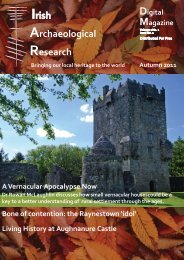Irish Archaeological Research Digital Magazine
Irish Archaeological Research Digital Magazine
Irish Archaeological Research Digital Magazine
You also want an ePaper? Increase the reach of your titles
YUMPU automatically turns print PDFs into web optimized ePapers that Google loves.
What is known of the <strong>Irish</strong> variant, Brandubh, is mostly known through the few surviving boards found, and a few<br />
scattered references to the game in <strong>Irish</strong> poetry of the 12 th to 16 th century which speak of a branán (a common term<br />
for chief) and his band of four, and “five men of white silver and eight of gold”. The boards themselves seem to vary<br />
little in layout – either a 7 x 7 grid, or a 6 x 6 grid with the game played on the intersections of the lines rather than<br />
on the squares. The quality and workmanship of the boards discovered ranges from high quality boards,<br />
exemplified by the ornately carved wooden board from Ballinderry Crannog 1 in County Westmeath, to what seem<br />
to be 'throwaway' graffiti boards roughly carved into stones and later discarded, much like the double‐sided board<br />
found during excavations at Cathedral Hill in Downpatrick. It seems likely that the game was played by high and low<br />
classes alike given the differences in quality of the boards, though whilst the graffiti boards seem to be carved as<br />
needed and discarded, the Ballinderry board at least seems to have been made with portability in mind. The heads<br />
protruding from two opposing sides of the board seem to have been intended for use as handles, suggesting<br />
portability was a concern, but also allowing two players to hold the board between themselves where flat or<br />
unstable surfaces were unavailable. In common with many modern travel games, the Ballinderry board was laid out<br />
with holes for pegged pieces, rather than a plain grid for counters.<br />
Replica coins used as counters<br />
on the game board.<br />
The exact rules for brandubh are unknown, as are those for hnefatafl in general. The closest record to the actual<br />
rules for hnefatafl were recorded by Carl von Linneaus in his diary of his travels through Lapland in 1732. The game<br />
he records and sketches the board for, closely resembles known hnefatafl and brandubh boards, save for having a 9<br />
x 9 layout. The king sits in the centre, protected by eight Swedes and attacked by sixteen Muscovites. Those that<br />
follow are assembled from a variety of sources – the rules that Linneaus records, those suggested by Walker for<br />
adapting the common Tablut and tafl rules to the brandubh board, and much practice and playtesting on the past of<br />
the author, both with and without the addition of mead for added authenticity. Whilst it cannot be claimed that the<br />
following rules definitely represent the most likely style of play, they do represent a relatively balanced style.<br />
Experimentation is encouraged though, particularly with players of opposing skill levels – changing the method of<br />
capturing the branán to surrounding on all four sides will swing the odds greatly in the favour the the defender,<br />
whilst allowing the centre square, once vacant, to count as a friendly square for the purposes of capture, will make<br />
the job of the attacker that much easier. In games where the balance is noticeably in favour of one side or the other<br />
good practice, and good manners, would suggest the players take turns at each side and count a game as consisting<br />
of two rounds, swapping sides between.<br />
<strong>Irish</strong> <strong>Archaeological</strong> <strong>Research</strong> Issue 2 Jan 2012<br />
36



